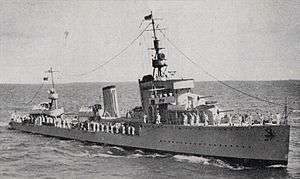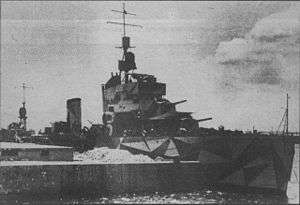Regele Ferdinand-class destroyer
 Regele Ferdinand | |
| Class overview | |
|---|---|
| Name: | Regele Ferdinand class |
| Builders: | Pattison, Naples |
| Operators: | |
| Preceded by: | Vifor-class destroyer |
| Built: | 1928-1930 |
| In commission: | 1930-1960s |
| Planned: | 4 |
| Completed: | 2 |
| Cancelled: | 2 |
| Retired: | 2 |
| General characteristics | |
| Type: | Destroyer |
| Displacement: |
|
| Length: | 101.90 m (334 ft 4 in) |
| Beam: | 9.60 m (31 ft 6 in) |
| Draught: | 3.51 m (11 ft 6 in) |
| Propulsion: | 2 shaft Parsons type geared turbines, 4 Thornycroft type boilers, 36,000 kW (48,000 hp) |
| Speed: | 35 knots (65 km/h; 40 mph) |
| Range: | 3,000 nautical miles (5,600 km; 3,500 mi) at 15 knots (28 km/h; 17 mph) |
| Endurance: | 480 t oil |
| Complement: | 212 |
| Armament: |
|
The Regele Ferdinand class was a group of two destroyers built in Italy for the Romanian Navy, which fought in World War II. Following the Soviet occupation of Romania in 1944, the two ships were seized and incorporated into the Soviet Black Sea Fleet. They were returned to Romania in 1953 and served until the 1960s when they were scrapped.
Design and construction
Following the end of World War I and the re-purchase of two Aquila-class cruisers from Italy, the Romanian Government decided to order also two modern destroyers from the Pattison Yard in Naples. The design was based on the British Shakespeare-class destroyer leaders. However they differed in that the turbines were in echelon layout.[1] The guns were supplied by Bofors and the fire control equipment by Siemens. The Romanians wished to order two more vessels but could not afford to do so due to economic problems.[1]
Specifications
The two ships of the Regele Ferdinand class were 101.90 metres (334 ft 4 in) long overall, with a beam of 9.60 metres (31 ft 6 in) and draught of 3.51 metres (11 ft 6 in). Each destroyer a complement of 212.[1] Each of the two warships displaced 1,422 tons standard with a full load displacement amounting to 1,880 tons.[2]
The vessels were powered by 4 Thornycroft type boilers giving an output of 36,000 kW (48,000 hp). This powered 2 shaft Parsons type geared turbines placed in echelon layout,[1] which gave the ships a maximum speed of 35 knots (65 km/h; 40 mph) and a range of 3,000 nautical miles (5,600 km; 3,500 mi) at 15 knots (28 km/h; 17 mph).[3]
The ships were initially armed with five 120-millimetre (4.7 in) guns in single mounts as their main armament. For anti-aircraft defense, the two destroyers were initially given one 76 mm (3 in) gun. Two German 37 mm anti-aircraft guns were also fitted by June 1941, as well as two twin 13 mm machine guns and two depth charge throwers.[4] For anti-ship warfare, the destroyers were armed with six 533-millimetre (21 in) torpedo tubes mounted in two groups of three, plus the capability to carry 50 mines and 40 depth charges in two racks. In 1943, the two warships were each fitted with German S-Gerät sonar. Their artillery was further modified during the course of the war, ultimately amounting to four 120 mm guns, four 40 mm anti-aircraft guns and eight 20 mm anti-aircraft guns.[5]
Ships
| Ship | Launched | Commissioned | Fate |
|---|---|---|---|
| Regele Ferdinand (RF) | 1 December 1928 | 7 September 1930 | Decommissioned in the 1960s |
| Regina Maria (RM) | 2 March 1929 | 7 September 1930 | Decommissioned in the 1960s |
Service history

The two destroyers were the most modern and powerful warships of the Axis powers during the Naval war in the Black Sea. However, they were not as heavy as the other two Romanian destroyerss, Mărăști and Mărășești (they were initially built as scout cruisers).
On 26 June 1941, Regina Maria helped repel a Soviet naval attack against the main Romanian port of Constanța, together with the flotilla leader Mărăști and the minelayer Amiral Murgescu. Surprised by the level of resistance and the accuracy of the return fire, the Soviet fleet withdrew, losing the destroyer leader Moskva into a Romanian minefield, laid by the Romanian minelayers Amiral Murgescu, Regele Carol I and Aurora on 19 June. Her sister ship Kharkov was damaged by Mărăști and the German coastal battery Tirpitz while the cruiser Voroshilov was also damaged by Romanian mines. Amiral Murgescu claimed to have shot down 2 Soviet aircraft and Mărăști claimed 1.[6][7]
On 17 December 1941, Regele Ferdinand depth-charged and sank the Soviet submarine M-59.[8][9][10]
In 1944, they were used in the evacuation of the Crimea by the Axis, Regele Ferdinand being heavily damaged and narrowly avoiding being sunk.
On the capitulation of Romania to the Soviet Union in August 1944, the two ships were incorporated into the Soviet Black Sea Fleet as Likhoy (Лихой, ex-Regele Ferdinand) and Letuchiy (Летучий, ex-Regina Maria), formally commissioned on 20 October 1944.[11] They were returned in 1951 and served under the numbers D21 and D22 in the Naval Forces of the Romanian People's Republic until the end of the 1950s.
See also
- Regele Ferdinand and Regina Maria frigates
- Romanian Naval Forces
References
- 1 2 3 4 Chesneau, p.361
- ↑ M. J. Whitley, Destroyers of World War Two: An International Encyclopedia, Naval Institute Press, 1988, p. 224
- ↑ Е. Е. Шведе, Военные флоты 1939—1940 гг., Рипол Классик, 2013, p. 119 (in Russian)
- ↑ Jipa Rotaru, Ioan Damaschin, Glorie și dramă: Marina Regală Română, 1940-1945, Ion Cristoiu Publishing, 2000, p. 255
- ↑ Janusz Piekałkiewicz, Sea War, 1939-1945, Historical Times, 1987, p. 350
- ↑ Jonathan Trigg, Death on the Don: The Destruction of Germany's Allies on the Eastern Front, Chapter 3
- ↑ Antony Preston, Warship 2001-2002, pp. 70 and 71
- ↑ Jipa Rotaru, Ioan Damaschin, Glorie și dramă: Marina Regală Română, 1940-1945, p. 67 (in Romanian)
- ↑ Donald A Bertke, Gordon Smith, Don Kindell, World War II Sea War, Volume 5: Air Raid Pearl Harbor. This Is Not a Drill, p. 63
- ↑ Nicolae Koslinski, Raymond Stănescu, Marina română in al doilea război mondial: 1944-1945, p. 361 (in Romanian)
- ↑ Monakov and Rohwer, p. 268